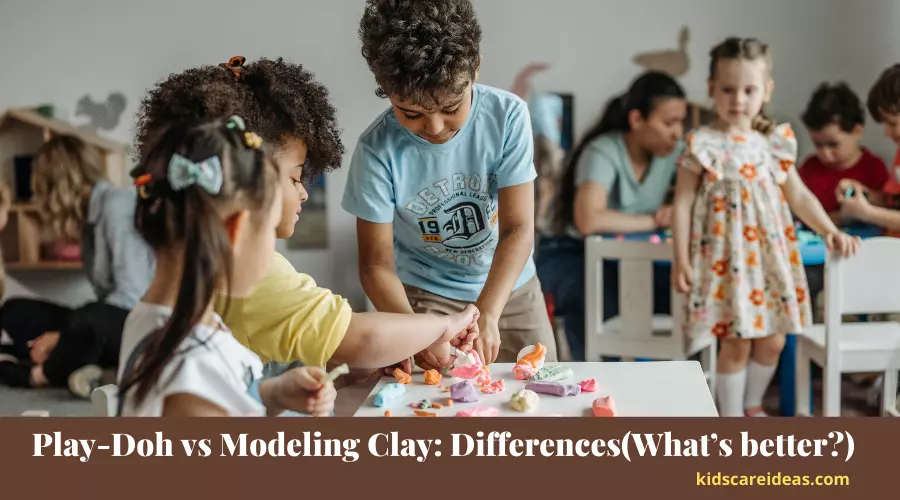Play-Doh and modeling clay are very different products.
Play-Doh is a soft clay-type substance used to mold, sculpt and make anything you can imagine.
If you want to know the comparison of Play-Doh vs Modeling Clay, then this is the right post.
It’s used as an educational tool in schools, a fun activity for children, and even a therapeutic tool for children with special needs.
On the other hand, modeling clay is a hard clay-type substance used to mold and sculpt, and it is used in art classes and as an artistic medium.
There are a few key differences between Play-Doh and modeling clay.
Let’s get started!
Play-Doh vs Modeling Clay
| Play-Doh | Modeling Clay | |
| Texture | Softer, Pliable, and Stickier | Less soft, and less sticky |
| Ingredient Type | Water-Based | Oil Based |
| Consistency | Soft | Harder and Drier |
| Residue in Hands | Do not leave residue | Leaves Oily Residue |
| Become Hard when left out | Does not become hard | Becomes Hard |

What is Play-Doh?
Play-Doh is a modeling compound used by children for art and craft projects, and it is made out of flour, water, salt, and oil.
I have found that Play-Doh wet modeling compound is a great way to introduce children to the world of 3D design, engineering and building.
It is fun and easy to use, it doesn’t require any complicated tools, and the final product can be assembled and disassembled repeatedly.
Also, it offers so many options that you can use it to create anything you can think of.
What is Modeling Clay?
Modeling clay is a material used by artists, sculptors, and animators to create three-dimensional objects.
It is made out of clay, water, and an additive such as sodium silicate or ammonia.
There are many different types of modeling clay, each with its properties.
Polymer clays can be molded, pressed, sanded, carved, painted, and stained.
Artists, sculptors, and animators often use modeling clay to create three-dimensional objects.
They may use wood or metal armatures to build their sculpture around.
After they have the armature, they will use their clay to make their final form.
Is Modeling Dough the same as Play-Doh?
Why is Modeling Dough Not the Same as Play-Doh?
No. Although they are clay-like materials, modeling dough is made from wax and oil-based ingredients rather than flour and water.
Professionals use modeling dough to create the molds of objects.
You then create sculptures, and it is made with wax, oil, and a clay-like compound.
On the other hand, Playdough is made from flour and water and has different textures and colors depending on the ingredients being used.
Playdough can be easily made from scratch at home or bought from the store, which is available as Play-Doh from Funskool, but modeling dough is typically purchased at the store.
Similarities of Modeling Dough and Play-Doh
Modeling Dough and Play-Doh are strikingly similar because they are easy to mold and manipulate each substance.
Modeling dough and Play-Doh are two of the best kinds of dough you can find.
Both are fun to play with and leave you with something to show for it!
While the ingredients for each might be a little different, the resulting product is similar.
Pros and Cons of Play-Doh
Pros:
- Inexpensive
- Non-toxic
- Available in many different colors
Cons:
- Sticks to hands and surfaces
- It becomes hard over time if not used
- Leaves a residue on hands and surfaces
Pros and Cons of Modeling Clay
Pros:
- Non-toxic
- It is safer on hands and surfaces than Play-Doh because of its dryness.
Cons:
- Not as many colors available as Play-Doh have.
- It is more difficult to use than Play-Doh, as it is harder and drier.
- It can become hard over time if not used, limiting its usability.
Can you Sculpt with Play-Doh?
Play-Doh is a popular clay-like substance that kids use to create various sculptures. But can you sculpt with Play-Doh?
The answer is yes, and you can sculpt with Play-Doh.
Play-Doh is a clay-like substance created using different ingredients like flour, salt, water, etc.
Play-Doh is designed to “behave” like clay and can be used to sculpt just like real clay.
Well, it depends really on what you are looking to sculpt in Play-Doh.
If you are looking to make a sculpture with smooth and fine details, you would need clay with a smooth texture, but if you are looking to make a big sculpture and have the details hidden within the piece, you could use Play-Doh.
Many have created amazing pieces with Play-Doh.
If it’s too hard, the Play-Doh will break or crumble when you try to shape it.
If it’s too soft, it will stick to your hands and never end up being the shape you want it to be.
The best consistency for sculpting with Play-Doh is when it’s just firm enough that it will hold its shape but not crumble.
It takes a little practice to get that perfect consistency, but once you get it, you’ll be able to sculpt just about anything you can imagine.
Can you Sculpt with Modeling Clay?
Modeling clay is a traditional toy that kids have used for decades to make models and figurines.
Parents and grandparents have likely purchased modeling clay for their kids and grandkids on several occasions or even received it as a gift themselves.
Modeling clay is excellent for kids, and it is moldable and easy to use. But can you sculpt with modeling clay?
The answer is yes, but it won’t be easy. Molding clay is excellent for kids to use, and it is soft and easy to manipulate.
It is excellent for kids to use when trying to learn how to use their hands.
It is also great for kids because they can make almost anything they want with it and use it to make the most detailed creations.
And it is great because once they are done with it, they can throw it away, and they don’t have to worry about cleaning it up, and they can throw it away.
Of course, if you want to clean it up, you can use a wet paper towel, but you don’t have to.
Play-Doh vs Modeling Clay: Which is better as a toy for kids?
Modeling clay is a superior modeling material to Play-Doh and other dough-type products for sculpting.
However, for kids who play, Play-Doh is better, and it is easier to mold and is more fun when used with cookie cutters and rolling pins.
Both are great tools, depending on what you need to achieve.
Here are some excellent Play-Doh choices:
- GREAT REFILL OR STARTER PLAY-DOH SET: Whether your...
- SHAPING IMAGINATION: From building their own...
- 10 PLAY-DOH CANS: This Play-Doh set includes...
- 42 mini Play-Doh cans in assorted colors for...
- Non-toxic, wheat-free modeling compound for ages 2...
- Great as party favors, classroom prizes, or...
- 6 CANS OF SCENTED PLAY-DOH COMPOUNDS: Dig into...
- FUN MIX-INS: Make your own combinations with all...
- REUSABLE: Keep your compounds soft, squishy, and...
- SHAPE THEIR SCHOOL YEAR: Teachers can inspire...
- 6 SETS OF 8 COLORS: Plenty of duplicate colors for...
- 3 OZ PLAY-DOH CANS: If you do the math, 48 cans...
What are the differences between Play-Doh, Modeling Clay and Polymer Clay?
Play-Doh, modeling clay, and polymer clay each have unique characteristics and uses. Play-Doh is a colorful, non-toxic, and soft material that is easy to manipulate, making it perfect for children’s art projects. Modeling clay is more firm and does not harden, making it ideal for sculpting intricate details. On the other hand, polymer clay is a versatile material that hardens after baking, allowing for lasting and durable creations. Understanding the polymer vs modeling clay comparison can help artists choose the best option for their specific needs and projects.
Conclusion
Let’s conclude the post on Play-Doh vs Modeling Clay.
Play-Doh and Modeling clay are both considered art supplies, but the differences between the two are subtle.
Both items are great for developing your child’s creativity and imagination, and modeling clay is great for kids that like to build different things.
On the other hand, you can use Play-Doh to create many different things, but it is messy.
You should decide which product you prefer, and then you should purchase it.
I hope you enjoyed reading the post.




